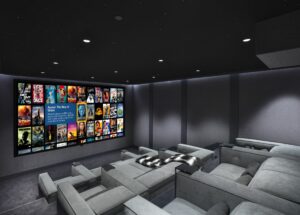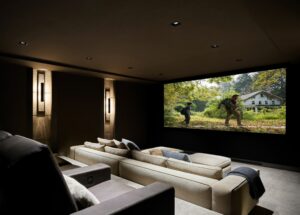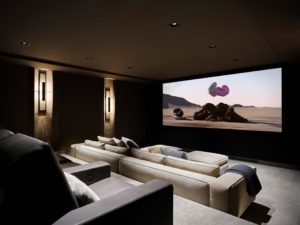Building on a Legacy
Harry Francis: A Cinematic Life
Imagine waiting all week for the only movie to be released. Consider the anticipation, a dark movie house, and lines of people surrounding the building. Crazy, right? Finally, the doorman welcomes you into an opulent movie palace with red carpets and velvet curtains and ushers in bowties where you can completely immerse yourself in another reality ensconced in Baroque, Rococo, Neoclassical, Art Nouveau or Art Deco architecture. And that is before the feature sweeps you away! Welcome to the Roaring 20s and the explosive growth of film. What a way to view a movie!
Advance two decades to the Great Depression, and Americans were ready to be transported more than ever, even if for only two hours. In a time when most families struggled to afford necessities, 60% of the population still faithfully escaped to the movies weekly, cementing the film industry as a cultural institution. While movie studios went bankrupt and more than one third of movie houses had closed, Americans saved their pennies to see a weekly movie and view the only release for that week. It wasn’t simply going to see a film. Moviegoers were looking for an escape, a few minutes to imagine themselves in a life not fraught with the drab reality of making ends meet. Luxurious movie palaces clothed in exotic architecture enrobed with sphinxes, phoenix birds, and gargoyles. Such elaborate buildings were found in even the smallest American towns. Upholstered seats, luxurious lobbies, and breathtaking chandeliers, the Golden Age of Hollywood emerged out of the trials of the Great Depression.
Innovation changed the movie industry after the 50s brought television into American homes and became common by the 60s. Film fought back with stereo sound, wide screens and finally to the technologies of today with immersive audio, digital cinema and CGI. But the explosion of cookie cutter multiplexes with numerous movie selections available in one location seemed to degrade the experience. It has since become a trend to watch movies in the comfort of your home theater, on a large-screen television, or even traveling with you on your phone or laptop. Movies to stream at a click. It became difficult to recall the glory days of film in a current culture abounding with a myriad of viewing options on any given day. But what has transpired with multiple choices is an indifference toward the artistry, glamor and excitement of the event. Add to that a global pandemic bringing communal viewing to a complete halt. Oh, how we have missed sharing the experience of a new release, anticipation of stunning visuals on stellar screens, sound that rumbles from within your torso, applause at the end of a fantastic movie moment!
While studios have implemented the latest technology in audio and video to create film presentations never before imagined, less than 10% of Americans view movies weekly in public theaters since early 2000. The ease of cozying up to viewing a movie at home or the lack of inspiration within today’s commercial box theaters have stunted our desire. Have too many choices reduced the value of film offerings? Diluted the quality of those theatrical experiences? What is the future of the Seventh Art? Providentially, the private cinema community has a unique opportunity to redefine the industry and reignite flames of excitement. We can take our inspiration from mentors who materialized during the glory days of Hollywood.
So many stories emerged from the film industry boom. Artists, technicians, enthusiasts. Individuals who fell in love with the glamor, thrill and inspiration of movies. One such example is a man who, graduating high school in 1930, began his career with a job switching out marquee lettering at his small hometown theater in Wilmington, CA. He fell in love with movies. Little did Harry Francis realize that he would one day rub shoulders with the elite of Hollywood in his 50-plus year career hosting celebrities, children and neighborhood moviegoers with a grace reminiscent of bygone eras, nor that he would be managing some of the most historic Los Angeles area theaters. For Harry, it wasn’t just about the most recent film released each Friday but also the experience of being transported to another reality and sharing that experience and passion with others. Relationships. Joy. Impact.
Harry engaged with everyone. Musings from a recipient of Harry’s children’s program shared on the Cinema Treasures website, “He loved the kids and would put on a Saturday Kids Show every week. He refused to play monster movies because he said our mothers would complain. But they always showed a film, ‘Crazy Races,’ about ten or 12 cartoons (the last one they would run upside down and backwards) and they had birthday cake for any kids who had a birthday during the week. He would stand on the stage with a microphone after the movie and give out the cake and prizes for those who had the winning number for ‘Crazy Races.’ Very fond memories.” Relationships.
Harry found joy in his theaters, loved sharing the magic of movies with others and “was a celebrity in his own right,” according to his grandson, Greg Francis, founder and CEO of Cinergy Construction. “Everybody knew Harry,” says Greg. “He was the face of that theater every day.” Greg, who caught the bug at an early age growing up in Harry’s theaters, muses “It was just like magic, you know?” He recalls what Harry bestowed on him, “What I remember is being at the theater and watching ‘Death on the Nile,’ I don’t know, like 25 times. We just kind of lived there cleaning up popcorn, free run of the movies, candy. I realize that everything comes from your childhood, right? It’s all subconsciously embedded in there. I’ve always had a love for the movies, but at a deeper level, I appreciate the story, the character, the character development, the cinematography.” Joy.
Dubbed “Mr. Westwood” by Warner Bros and the community, Harry also received accolades from professional members of the cinema community as the “Godfather” of Westwood Village. He was considered a “lucky charm” for studio heads, and was presented with a Lifetime Achievement Award “Oscar” during his movie-premiere themed 80th birthday party in 1991 at the Bruin Theatre of Westwood Village, CA. Former President Ronald Reagan recognized his impact in a birthday message, stating, “Birthdays are a time to reflect on the beauty and richness of life and to share memories and hopes with family and friends. Over the years, you have dedicated yourself to theater management and you are to be commended for a job well done!” Characters like Harry, with their love and passion for sharing cinema, the Seventh Art, with others, are an inspiration. Impact.
The cinema connoisseur community is built on broad shoulders of men like Harry who had the drive to share their love for the art of film. Now is the time for all of us within our community to embrace art and elevate expectations. “I want to see it carried on the way that movies have been from the beginning. You walked in, it was this grand theater,” Greg states, relating it to luxury private cinemas. “It’s very different from everything else in the rest of the house. It’s a whole individual environment in itself they get to create. It’s artistic.” Not simply a room to watch movies, but a shared cinematic experience. “This allows people to have the experience again, probably the way they felt when my grandfather first watched movies, when they first came out with sound.”
“There is a renaissance in a way,” foretells Greg, “Dedicated rooms with that experience.” Recognizing that today we are so easily distracted, and viewing on small device screens cannot enrobe viewers in the movie environment. “You’re not going to get the emotions and feelings that you have when you watch something on a big screen the way it was intended,” said Greg. He loves the beauty and magic in theaters his company builds that are reminiscent of the “places of my memories” while embracing the enhanced sound and video offered by today’s technological advancements.
Harry’s legacy and his vision for cinema is in good hands with community members dedicated to the love of cinema and a passion to share that love with others. Movie palaces were a mixed bag of opulent architecture designed to pique the imagination of movie goers, a mode of escape for Depression-era Americans indulging senses with sights, sounds, textures, smells. And taste buds. Let’s not forget the buttery goodness of theater popcorn! These monuments to the movie industry lay the groundwork for a new century of luxury private cinemas where we can reconnect while enveloped in the environment of film carrying on the legacy of those who inspire us. Greg states, “He (Harry) liked the social aspect of it, and I think he would really appreciate it. He’d probably be pretty emotional about it.”
So, what’s in store for the future of our private cinema community? More than artfully painted ceilings and walls designed to transport moviegoers to exotic faraway destinations, cinema is now firmly entrenched within our very own homes. We have come full circle. And yet, how do we embrace the joy and excitement of our art? Just imagine Harry in your private cinema, stepping up to center stage prior to showing the latest release. Setting the stage for the performance, engaging senses, building anticipation, and whetting appetites for the main course. As cinema connoisseurs step away from the concerns of work, chores, and societal worries we once again escape into the art of film, fully ensconced within the luxury of our private movie oasis. A private cinema designed with our personal vision in mind. Where we share experiences that enrich the relationships with those we hold most dear.







